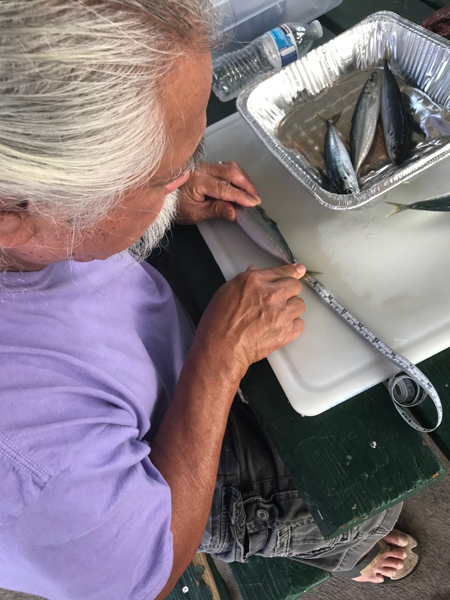E Hui Pū: a collaborative approach to understand climate change impacts on traditional Hawaiian ‘ōpelu (mackerel scad) aggregation sites in South Kona, Hawai‘i

The overall goal of the proposed project is to understand how climate change, specifically increases in ocean temperature, impact the abundance of the South Kona ‘ōpelu fishery. The study will use integrated monitoring approaches to define critical fishery resources and the importance of traditional ‘ōpelu fishing practices. The ‘ōpelu (mackerel scad, Decapterus macarellus) fishery is well-established and vitally significant for Hawai‘i’s people, both economically and culturally. However, the fishery has declined in recent decades, which is thought to be caused by changing climate conditions and unsustainable fishing practices. Through proper management the ‘ōpelu fishery has the potential to regenerate to historical levels and continue to provide both economic and cultural benefits for the community.
This project has four main goals: 1) to clarify coastal dynamics at ‘ōpelu ko‘a (traditional fish aggregation sites) by combining environmental indicators, ‘ōpelu reproduction information, and fisher knowledge; 2) to better define the spawning time of ‘ōpelu by conducting a reproductive assessment of South Kona ‘ōpelu; 3) to use research on seasonal and climatic changes to bring greater insight to historical information of the ‘ōpelu fisheries; and 4) to encourage sustainable management and harvest practices based on traditional knowledge and accumulated scientific data.
Ultimately, by pooling knowledge sources gained through this project and its collaborative partnerships, we will be able to suggest best practice adaptations, based on environmental and fishery connections, for Hawaiian communities to apply to local fishing practices and state management actions to minimize climate impacts. This project will serve as an example for integrating knowledge sources and creating joint participation of communities, scientists, NGOs, and governmental agencies to inform climate adaptation practices in Hawai‘i and beyond.
Project Collaborators
Faculty Members
- John Burns – UH Hilo Marine Science faculty, PI and advisor on water quality monitoring and analysis
- Tim Grabowski – U.S. Geological Survey, Hawaii Cooperative Fishery Research Unit; fisheries dynamics, monitoring and analysis advisor
Natural and Cultural Resource Managers
- Charles Young – KUPA Friends of Hoʻokena Beach Park, Hoʻokena community representative, co-lead (with DLNR – DAR) on management action development and implementation in Hoʻokena, and coordinator of Hoʻokena fisher monitoring
- Kaimi Kaupiko – Kalanihale Foundation, Miloliʻi community representative, co-lead (with DLNR – DAR) on management action development and implementation in Miloliʻi, and coordinator of Miloliʻi fisher monitoring
- Luna Kekoa – DLNR – Division of Conservation and Resources Enforcement, Makai Watch Coordinator, liaison with DAR biologists and DOCARE officers on project research and incorporate research findings into South Kona ʻŌpelu Management Area community-based co-management actions
- Ulu Ching – Conservation International-Hawaiʻi Senior Program Manager, oversee project implementation, reporting and communications with project team and PICASC
- Eva Schemmel – Conservation International-Hawaiʻi Science Advisor, Oversee and advise ʻōpelu reproduction assessments
- Kēhau Springer – Conservation International-Hawaiʻi Community Capacity Development Advisor, Co-lead on project implementation and collaborative team dialogue facilitation. Support Hawaiian language-based and historical (science and oral traditions) research
- Blake McNaughton – Kamehameha Schools, advise on project expansion in region with additional stakeholders
Early Career Professional
- Courtney Hurt – UH Hilo Marine Science alumni, Co-lead on co-development & implementation of research project with community members and collaborative team
PROJECT DETAILS
FUNDED:
FY2020
PI:
Ulu Ching
Hawaiʻi Senior Program Manager
Conservation International
John Burns
Assistant Professor of Marine Science
UH Hilo
Co-PIs:
Tim Grabowski
Research Fish Biologist, Hawai‘i Cooperative Fishery Research Unit, USGS
Adjunct Professor of Marine Science, UH Hilo
Courtney Hurt
Consultant, Conservation International
Charles Young
Hoʻokena Community Representative
KUPA Friends of Hoʻokena Beach Park
Kaimi Kaupiko
Miloliʻi Community Representative
Kalanihale Foundation
Luna Kekoa
Makai Watch Coordinator
DLNR Division of Conservation and Resources Enforcement
Eva Schemmel
Hawaiʻi Science Advisor
Conservation International
Kēhau Springer
Hawaiʻi Community Capacity Development Advisor
Conservation International
Blake McNaughton
Kamehameha Schools

